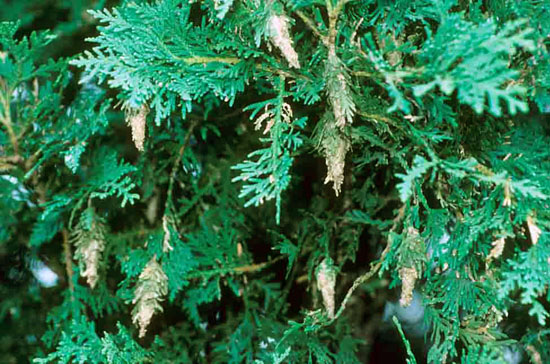Issue 5, May 21, 2012
Bagworms
Hatching bagworms were found in the Champaign-Urbana area of central Illinois on May 14. Hatching typically occurs in the first half of June, so they are two to four weeks early. The phenology indicator is catalpa full bloom, which was occurring early this week. We recommend that treatment be delayed for two weeks after hatching to allow ballooning to finish. Hatch would have occurred in southern Illinois about two weeks ago, so it is time to treat in that portion of the state.
Bagworm overwinters as eggs in the female bag. They hatch in late spring, exiting the bottom of the bag. The tiny caterpillars climb to the top of the tree where they each spin out a silk strand 1 to 3 feet long. This catches in the wind and carries the tiny larva wherever the wind blows. This is called ballooning. The larva then crawls to the top of whatever the silk caught onto and may repeat the process until it lands on a suitable host. The bagworm population continues this process for about 2 weeks. With this form of migration, it is no surprise that bagworms feed on a wide range of hosts. Eventually, the larvae are faced with the choice of feeding on what they land on or starving to death. They are most common on spruce, eastern red cedar, other junipers, arborvitae, white pine, crabapple, and pin oak but are found on many other species of trees and shrubs. They are more common on deciduous hosts in southern Illinois than farther north.
Bagworm larvae feed on the edges of broadleaf foliage, sometimes to the midvein. Leaves of needled evergreens are eaten back to the base until nothing remains. Defoliated needled evergreen branches or entire trees frequently die. Because bagworms start at the top of the tree and work their way downward, it is common to see the top third of evergreens dead due to defoliation. Deciduous trees will refoliate, with the damage being primarily aesthetic.

Bagworms feeding on arborvitae.
Upon leaving its mother's bag, the newly hatched bagworm spins a silk tent and covers it with whatever is available, typically the host vegetation. The bagworms feed through the summer. As the caterpillars grow, they increase the size of the spindle-shaped bags up to 1-1/2 inches long. There is only one caterpillar per bag. Pupation ranges from mid-August to very early September. Male larvae go through five larval instars; female larvae go through six. For this reason, male bags tend to be smaller than those of the females, and they pupate sooner. As long as the caterpillar is feeding, it places bits of host foliage around the top of the bag. Once it has pupated or died, this practice stops and the top of the bags turn from green to brown. This is useful in scouting because pupated bagworms are not susceptible to insecticide sprays, and killed bagworms do not fall from the tree.
Adult male bagworms are about ½-inch-long black moths with clear wings. Adult female bagworms are larviform; that is, they emerge from the pupa looking similar to caterpillars. The non-feeding males fly from bag to bag, mating with the females inside through the bottom of the bag. The non-feeding females fill most of their bodies with eggs and die in the bag. Each female bag contains 300 to 1,000 eggs.
Because bagworm eggs overwinter in the old bags, an effective control measure on shrubs and smaller trees is to handpick the bags from September into spring and destroy them. Because the sex ratio in bagworms is about one-to-one, every other bag on average will contain 300 to 1,000 eggs. Bacillus thuringiensis kurstaki (Dipel, Thuricide), spinosad (Conserve), cyfluthrin (Tempo), permethrin (Astro), and other pyrethroids are effective even on older larvae. Even so, they are more effective on younger larvae, so treatment soon after they stop ballooning is recommended. In addition, controlling younger larvae prevents the damage that would be caused by the larvae through the season. (Phil Nixon)
Author:
Phil Nixon